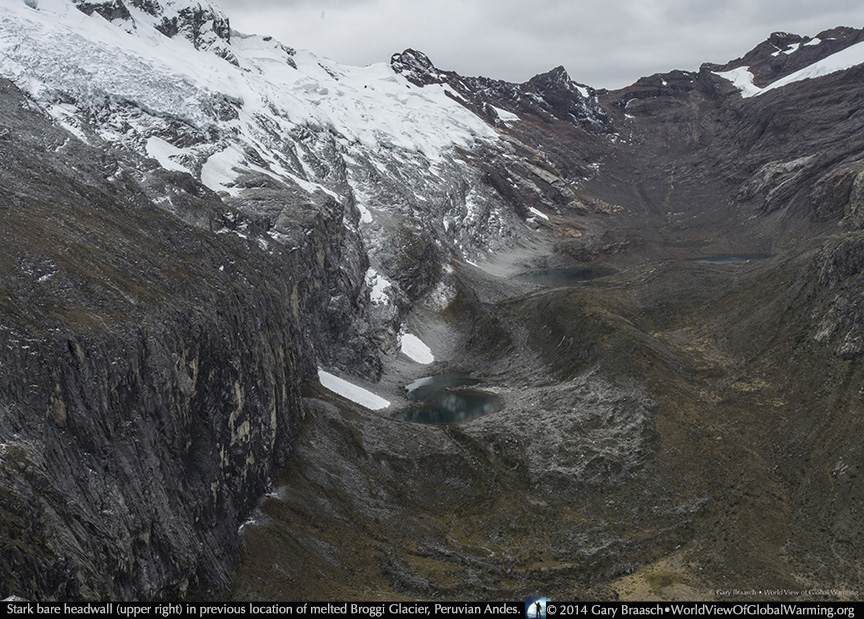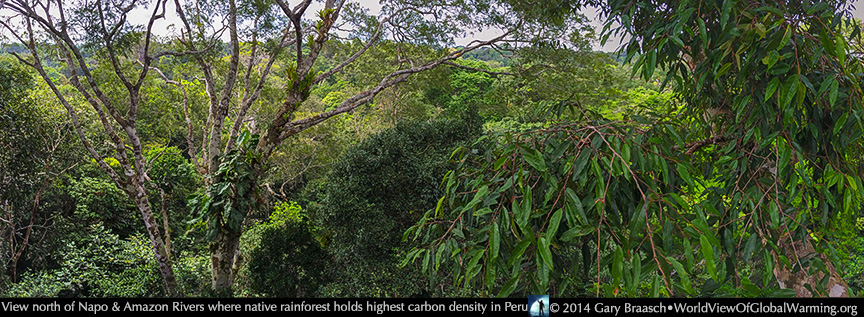Climate Photo of the Week
Update February 24, 2015: President Obama vetoed the bill to force his hand on the Keystone pipeline, keeping the final decision in the Executive Branch. For details, see NY Times.
Keystone XL gets legal boost from Nebraska court as GOP Congress votes to build it and President signals a veto — a symbolic sideshow in the real need to leave most fossil fuels in the ground.
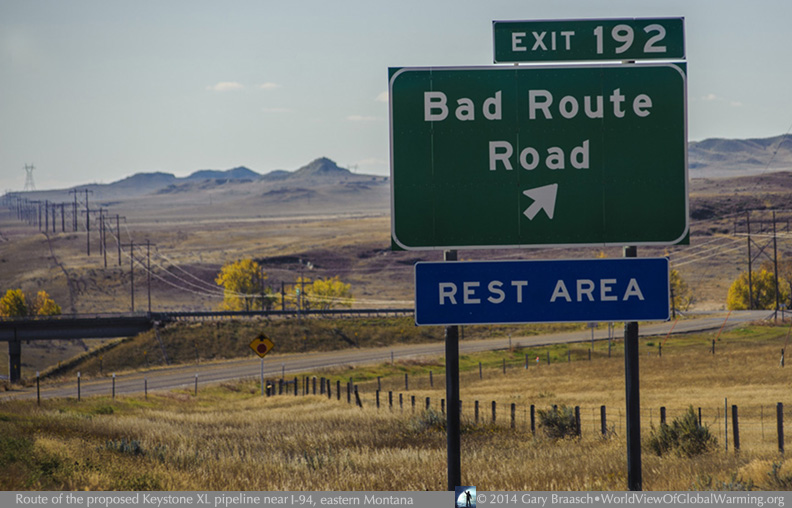
The Keystone XL oil pipeline, proposed to carry greenhouse gas-intensive oil sands crude from Canada to U.S refineries, moved one step closer to a White House decision, as the Nebraska Supreme Court let stand a state law to allow construction. The State Department, which will issue a final recommendation to the President on the international pipeline, had said it was waiting for the Nebraska decision to complete its review. The President has the final say. Congress, now controlled by Republicans, is going to vote to build the pipe, trying to force the President’s hand, but the White House said such a bill would be vetoed.
Obama vowed in June 2013 to okay the project only if it "does not significantly exacerbate the problem of carbon pollution." The State Department's Environmental Impact Statement in 2014 concluded there was little additional environmental risk from the pipeline. The Department says it is reviewing and appropriately considering the more than 2.5 million public comments, as well as information from other agencies, it received during the comment period on the EIS.
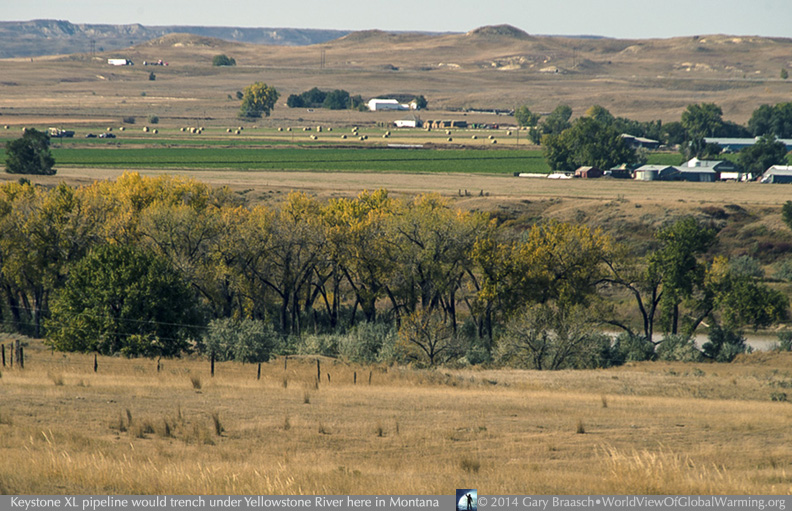
Environmental leaders demand that the Keystone XL oil sands crude pipeline not be built, because of the extra level of emissions, pollution risks and the encouragement of demand for fossil fuels in the face of climate change. There is also local opposition along the route. It has become a well chewed-over bone of political contention. While Republicans and the oil industry tout jobs and benefits to American oil supply and prices, the major benefits would appear to flow to Canadian corporations and companies that are part of the conservative Koch brothers holdings. President Obama used an appearance on The Colbert Report to downplay the project, saying of jobs that “there aren’t a lot.” “Essentially," the President continued, "it is Canadian oil passing through the United States to be sold on the world market. It’s not going to push down gas prices here in the United States.”
The 36-inch pipe will be dug in about 5 feet deep along a 110 foot construction corridor across the Canadian border to Kansas, crossing 62 large rivers, lakes and wetlands, but will be tunneled deeper under major rivers like the Yellowstone and Missouri. In Kansas it would link with existing pipes to Texas.
This controversy is strongly symbolic of the decisions that must be made to control rapid global warming from the use of fossil fuels, but is a very tiny action in the huge changes that are demanded by the science of climate change. The United States, as the second largest current producer of greenhouse gases and the largest throughout the entire industrial age is decidedly schizophrenic about energy and the climate. As the New York Times pointed out, the Obama Administration quietly approved a similar pipeline carrying oil sands petroleum through the U.S. in 2009. It has encouraged an “all of the above” policy for energy, including the gas and oil rush that gushed forth from fracking technology. American oil and gas production is now influencing world markets, helping drive prices down.
On the other hand, the EPA is working toward new regulations of coal-burning power plants which will be written this year. New vehicle fuel efficiency standards will result soon in 50 mpg fleet mileage levels. Solar and wind electricity production and building energy efficiency are being advanced. And in an announcement that surprised the world and perhaps set the stage for a long-sought international agreement to fight climate change, the U.S. and China jointly announced stepped up greenhouse gas emission reductions.
This push and pull between free-wheeling energy production, including coal and oil, and the need to sharply reduce the burning of fossil fuels can not long continue. The U.S. and the world must leave most fossil fuels in the ground. On the heels of the latest IPCC reports of severe effects of climate change now and the U.S. National Assessment showing how Americans are already feeling and paying for global warming, came a report in the journal Nature that most fossil fuel reserves in the world can not be used without causing severe climate change disruptions. The study said “globally, a third of oil reserves, half of gas reserves, and over 80 percent of current coal reserves should remain unused from 2010 to 2050 in order to meet the target” on which UN climate negotiations are based. The U.S. and the world must leave most fossil fuels in the ground, and apply the ingenuity, resources and funding used on them to develop the non-carbon technologies that are ready to be exploited.
Every nation agrees to agree to reduce global warming pollution at contentious climate negotiations in Lima — as Peru's great ecosystems and the people they support show the stresses of rising temperatures.
One of the most dramatic changes in Peru is the disappearance of Broggi Glacier in Huascaran National Park, a World Heritage site northeast of Lima.
Against the daunting backdrop of Peru’s glaciers disappearing, reductions in water for millions, and extinctions and forest migration in the Amazon rainforest, the 20th international UN Climate Convention, meeting in Lima in early December, laid plans for a long-sought all-nation agreement to stop the rise in the greenhouse gas emissions responsible for global warming. Faced with climate change realities playing out worldwide, as starkly reported by this year's Fifth IPCC assessment, negotiators in Lima took steps toward an international agreement which would for the first time commit all nations to plan reductions in their emissions. National plans will be announced during the coming year and a final new agreement under the Climate Convention will be negotiated for signing at a Paris meeting a year from now. The Lima talks broke down early over how strict limits to global warming emissions would be reported and verified and over support for those nations and people already affected by rapid changes. There were other vast differences between developed and developing nations. Many of these details remain to be worked out in the coming year.
The diverse rainforest of the Peruvian Amazon basin to the east of the Andes, an area larger than France, is one of the deepest reservoirs of sequestered carbon on our planet. But its biodiversity is already changing with losses of frog species, tree species moving as temperature rises, and increased mining.
The limits expected in national reduction plans are not going to be enough to stop increasingly high temperatures and climate disruptions, most analysts said. The individual national plans have no mandatory amount of reduction, will not be independently verified, and only just before the Paris talks will the world know how much they accomplish. But the national plans would set the stage for an agreement by all 195 Convention signatories at the 2015 meeting -- which would be the first time all treaty parties together begin to follow the words of the Climate Convention: “to achieve stabilization of greenhouse gas concentrations in the atmosphere at a low enough level to prevent dangerous anthropogenic interference with the climate system.”
It is now too late, say most scientists, to follow the next sentence of the Convention, to achieve reductions "within a time-frame sufficient to allow ecosystems to adapt naturally to climate change, to ensure that food production is not threatened and to enable economic development to proceed in a sustainable manner.” Under the Lima plan limits to carbon pollution would not take effect until after 2020, despite many nations wanting an agreement to begin much sooner. Developing nations left the Lima meeting dissatisfied about adaptation and preparedness funding from developed nations. But there is hope, determination, and pathways for action which can certainly slow the accelerating rush toward a disastrous century — if the world’s nations decide to act more decisively. The new promises by the U.S., China and the E.U. to slow and cut their pollution are an example of what we might expect to see from all countries in the coming year. Going farther toward really deep and faster emission reductions will depend on peer pressure and negotiation among nations — because the process adapted at Lima does not have top-down emissions limits like the Kyoto Protocol did. It appeared that only a flexible, non-forcing approach allowing for "differentiated responsibilities and capabilities” was able to get all 195 nations to sign on.
More on Peru's environment as it reacts to climate change, from World View of Global Warming's 2014 coverage, here.

15 years of World View of Global Warming, documenting climate change 1999-2015
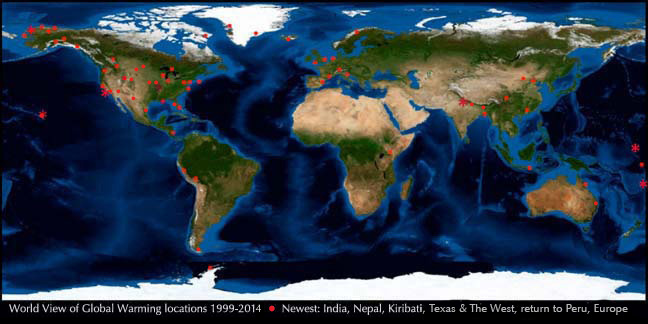
This project would be impossible without scientists and observers around the world who have provided hundreds of scientific contacts and papers. See Background, Advisors, and Reference for documentation, funders and major advisors, without whom I could not complete the work.
World View of Global Warming is a project of the Blue Earth Alliance, Seattle Washington, a 501(c)3 tax-exempt organization. The project is supported entirely by donations, grants, and license fees for the photographs. Please see information about how to contribute.
For other information about Gary Braasch's climate change projects and books, please see the books Earth Under Fire and How We Know What We Know About Our Changing Climate, and the exhibit "Climate Change in Our World" at the Books and Exhibits link on the top menu of this page.
COPYRIGHT NOTICE:
Photography and text Copyright © 2005 - 2017 (and before) Gary Braasch All rights reserved. Use of photographs in any manner without permission is prohibited by US copyright law. Photography is available for license to publications and other uses. Please contact requestinformation@worldviewofglobalwarming.org. View more of Gary Braasch's photography here.



